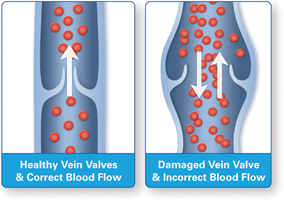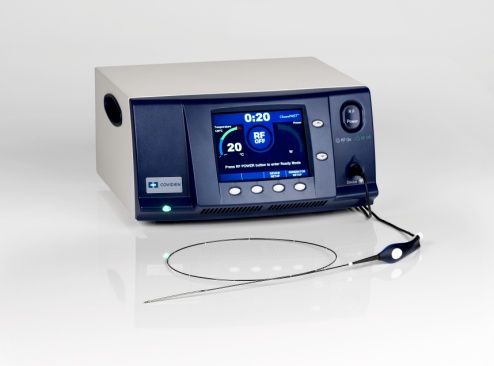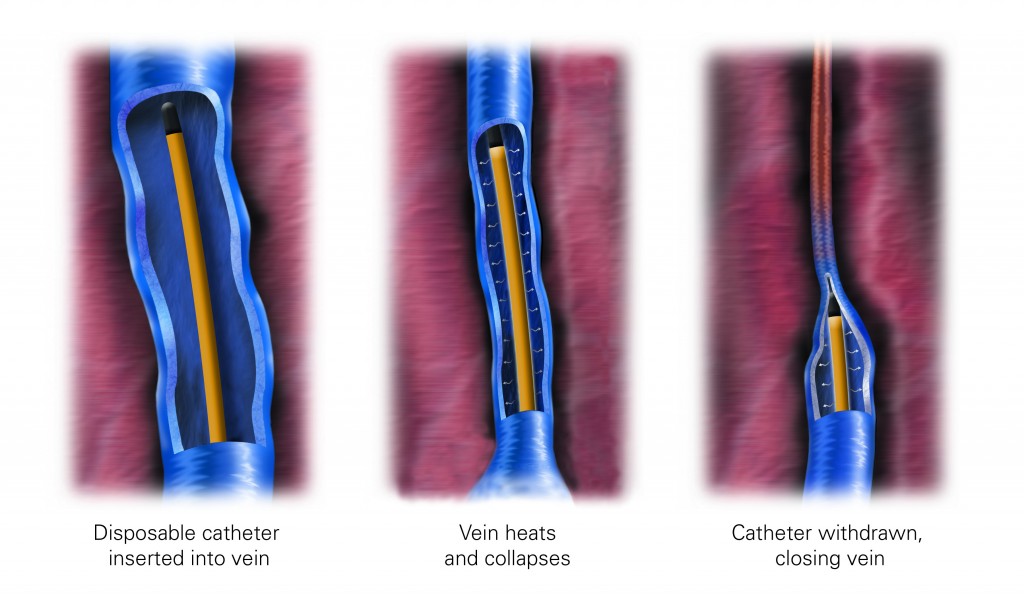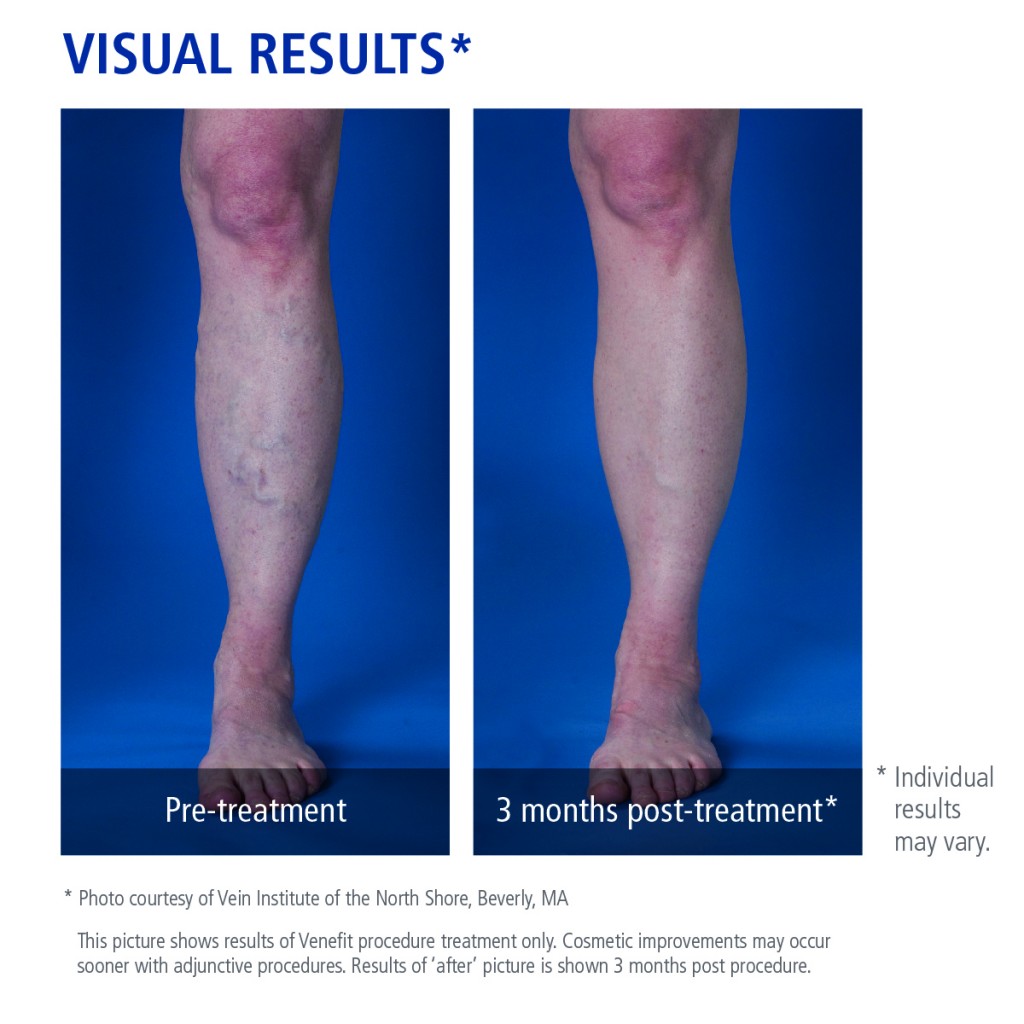VEIN TREATMENTS
Varicose Vein Treatments
If it’s been years since you felt comfortable showing off your legs, now is the time to do something about it. While many varicose vein conditions are cosmetic, they can lead to more serious health issues. At the Advanced Vein Center, we offer solutions.
TREATMENT OPTIONS
SCLEROTHERAPY FOR VARICOSE VEINS
Sclerotherapy is a simple and effective, noninvasive procedure for small varicose veins. The Procedure Sclerotherapy is the most common way to treat small to medium varicose and spider veins. In this procedure a solution is injected into the varicose vein causing the vein to be reabsorbed by the body. This is a simple office procedure that only takes 30-60 minutes. In some cases repeated treatments may be necessary. After treatment, you will be required to wear compression stockings for a short duration to assist with the reabsorbtion of the spider veins. Walking immediately after the procedure is encouraged.
Before treatment, a complete medical history is taken and a thorough medical examination is conducted. This is done to determine how long the problem has existed, the severity of the symptoms, and whether or not the condition is affected by physical activity. It is also done to see if you have undergone prior surgery or other vein therapy. At this time, the physician assesses if your deep vein system is affected. If so, he or she may recommend that you have another procedure prior to undergoing sclerotherapy.
The Advanced Vein Center will provide comprehensive patient preparation guidelines to optimize your vein treatment experience.
The Benefits
The benefits of sclerotherapy for varicose veins include:
- Reduces or eliminates unsightly veins.
- Does not interfere with normal daily activities
- Safe, virtually painless, in-office treatment
- Relief of symptoms
- Nearly immediate visible results
After The Procedure
Patients who have had sclerotherapy have reported little discomfort. Some experience a slight to moderate burning sensation immediately after the injection, but this disappears within a few seconds. An ointment to soothe the skin and relieve the burning may be used, and a pressure bandage may be applied to prevent post-injection bleeding. Some physicians prefer to use compression stockings. Others use compression bandages.
Sclerotherapy patients are generally advised to return to normal daily activity immediately following the procedure. Vigorous physical activity, however, is discouraged for 24 hours. Walking immediately after sclerotherapy is encouraged because it increases blood flow through the remaining healthy veins that bring blood back toward the heart. Elevating the legs usually isn’t recommended unless large varicose veins have been treated.
Most patients experience no adverse effects from sclerotherapy, but some minor side effects have been reported. These include slight blistering that occurs when small amounts of the injected solution seep into the surrounding areas. This usually goes away with time, and additional treatment with bleaching agents can help.
Bruising around the treated area can result if the veins are unusually weak, but this eventually disappears. Fair-skinned people tend to bruise more than dark-skinned people. Clots sometimes develop at the injection site. Although not a major cause for concern, it may be necessary to remove these clots within two weeks to better allow the healing process to progress normally.
A small percentage of patients develop a network of tiny pink vessels that turn white when pressure is applied. This condition, referred to as matte telangiectasias, usually disappears without treatment, but sometimes injection treatment is needed. Occasionally, patients have allergic reactions to the injected solution. When this occurs, antihistamines and other medications are prescribed to offset the reaction right away. When large varicose veins are treated, wearing compression stockings is recommended to prevent recurrence.
View complete Sclerotherapy patient preparation and post procedure directions.
Before & After Photos

VENEFIT™: TARGETED ENDOVENOUS THERAPY
Overview Varicose Veins & Chronic Venous Insufficiency (CVI)
More than 30 million Americans suffer from varicose veins and the more serious form of venous disease called Chronic Venous Insufficiency (CVI), yet only 1.9 million seek treatment each year.1,2,3 If the disease is left untreated, varicose veins can progress to become CVI with symptoms that worsen over time. Fortunately, diagnosing and treating this disease early can halt its progression.
 Understanding the Condition
Understanding the Condition
What are Varicose Veins?
Varicose veins are enlarged veins that can be blue, red or flesh colored. They are often raised above the skin on legs and look like twisted, bulging cords. They can also be associated with pain, aches, heaviness, restless legs, or burning and itching of the skin.
What is Chronic Venous Insufficiency (CVI)?
Chronic Venous Insufficiency (CVI) is a progressive medical condition that may worsen over time. As varicose veins progress to become CVI, other painful symptoms like leg swelling, skin damage and ulcers may occur.4,5 There are a number of factors that contribute to varicose veins and CVI, including pregnancy and heredity.4

 Venefit™ Targeted Endovenous Therapy
Venefit™ Targeted Endovenous Therapy
We proudly offer the Venefit™ procedure, formerly known as the VNUS Closure™ procedure, for the treatment of varicose veins and CVI.
The Venefit™ procedure is a minimally invasive segmental ablation treatment that utilizes radiofrequency (RF) energy to provide an even and uniform heat to contract the collagen in the vein walls, causing them to collapse and seal. Once the diseased vein is closed, blood will re-route itself to other healthy veins.

The Venefit™ procedure allows for a quick, comfortable recovery and a return to everyday activities for the average patient, while also improving the appearance of varicose veins.6,7

The Venefit™ procedure has been proven in clinical studies to have excellent long term effectiveness, with less pain and bruising than endovenous laser*.7
*A comparison of the patient experience between those treated with the Venefit ™procedure, using the Covidien ClosureFast™ Endovenous Radiofrequency Ablation (RFA) Catheter, and those treated with 980nm laser ablation.
Frequently Asked Questions
NOTE: Reference materials are below.
1. What is Venefit™ targeted endovenous therapy?
The Venefit™ procedure is a minimally invasive treatment option that uses radiofrequency (RF) energy to effectively treat patients suffering from varicose veins or chronic venous insufficiency (CVI). A vein specialist inserts the ClosureFast™ catheter into the diseased vein to provide consistent and uniform heat to contract the collagen in the vein walls, causing them to shrink and seal closed. Once the diseased vein is closed, blood will re-route itself to other healthy veins.
2. How is the Venefit™ procedure different from the VNUS Closure procedure?
The Venefit™ procedure is just a new name for the VNUS Closure procedure, providing the same clinically proven results with the same great patient recovery profile.
3. How is the Venefit™ procedure different from vein stripping?
During vein stripping, incisions are made in the groin and calf, and a tool is threaded through the diseased vein to pull the vein out of the leg. With the Venefit™ procedure, only one small incision is made at the insertion site and the vein is then treated and left in place. This minimally invasive approach reduces the likelihood of pain and bruising.a,b
4. How is the Venefit™ procedure different from endovenous laser?
Although the Venefit™ procedure and endovenous laser ablation are both minimally invasive procedures, a comparative, multi-center study showed that the Venefit™ procedure was associated with statistically significant lower rates of pain, bruising and complications. Patients undergoing the Venefit™ procedure also reported improvements in quality of life measures up to four times faster than patients treated with endovenous laser ablation (the study was conducted with a 980nm laser). c
5. How long does the Venefit™ procedure take?
The Venefit™ procedure takes approximately 45-60 minutes, although patients may normally spend 2-3 hours at the medical facility due to normal pre- and post-treatment procedures.
6. Is the Venefit™ procedure painful?
Most patients report feeling little, if any, pain during the Venefit™ procedure.3 Your physician should give you a local or regional anesthetic to numb the treatment area.
7. Does the Venefit™ procedure require anesthesia?
The Venefit™ procedure is usually performed under local or regional anesthesia. It is generally performed in a vein specialist’s office or an outpatient surgical facility.
8. How quickly after treatment can I return to normal activities?
Patients treated with the Venefit™ procedure may resume normal activities more quickly than patients who undergo surgical vein stripping or endovenous laser ablation. With the Venefit™ procedure, the average patient typically resumes normal activities within a few days.d
For a few weeks following the treatment, your physician may recommend a regular walking regimen and suggest you refrain from very strenuous activities (heavy lifting, for example) or prolonged periods of standing.
9. How soon after treatment will my symptoms improve?
Most patients report a noticeable improvement in their symptoms within 1-2 weeks following the procedure.c
10. Is there any scarring, bruising or swelling after the Venefit™ procedure?
Patients report limited to no scarring, bruising or swelling following the Venefit™ procedure using the ClosureFast™ catheter.c
11. What potential risks and complications are associated with the Venefit™ procedure?
As with all medical procedures, potential risks and complications exist including vessel perforation (when the catheter punctures the vein wall), thrombosis, pulmonary embolism (when a blood clot travels to the lungs), phlebitis (inflammation of the vein), infection, nerve damage, arteriovenous fistula (an abnormal connection between an artery and a vein), hematoma (bruising), and skin burn. As with all medical procedures, consult your physician to understand the risks and benefits of the procedure.
12. Is the Venefit™ procedure suitable for everyone?
Only a vein specialist can tell you if the Venefit™ procedure is the right option for your vein problem. Experience has shown that many patients with varicose veins or CVI can be treated with the Venefit™ procedure.
13. Is age an important consideration for the Venefit™ procedure?
The most important step in determining whether or not the Venefit™ procedure is appropriate for you is a complete ultrasound examination by your vein specialist. Age alone is not a factor in determining whether or not the Venefit™ procedure is appropriate for you. The Venefit™ procedure has been used to treat both women and men across a wide range of ages.
14. How effective is the Venefit™ procedure?
The Venefit™ procedure has been shown in a large international, multi-center study to be 93% effective over three years.e
15. Is the Venefit™ procedure covered by my insurance?
Many insurance companies pay for the Venefit™ procedure in part or in full. The Venefit™ procedure has coverage policies with major health insurers. Please discuss your coverage with your insurance provider prior to seeking treatment.
FAQ References:
a. LurieF, Creton D, Eklof B, Kabnick LS, Kistner RL, Pichot O, et al. Prospective randomized study of endovenous radiofrequency obliteration. (Closure procedure) versus ligation and stripping in aselected patient population (EVOLVeS Study). J Vasc Surg 2003;38;2:207-14
b. Hinchliffe RJ, et al. A prospective randomised controlled trial of VNUS Closure versus Surgery for the treatment of recurrent long saphenous variscose veins. Eur J Vasc Endovasc Surg 2006 Feb;31;2:212-218
c. Almeida JI, Kaufman J, Göckeritz O, et al. Radiofrequency endovenous ClosureFast versus laser ablation for the treatment of great saphenous reflux: a multicenter, single-blinded, randomized study (RECOVERY Study). J Vasc Interv Radiol. 2009;20:752-759.
d. L. H. Rasmussen, M. Lawaetz, L. Bjoern, B. Vennits, A. Blemings and B. Eklof, Randomized Clinical Trial Comparing Endovenous Laser Ablation, Radiofrequency Ablation, Foam Sclerotherapy and Surgical Stripping for Great Saphenous Varicose Veins. British Journal of Surgery Society Ltd., Wiley Online Library, www.bjs.co.uk, March 15, 2011.
e. Proebstle T. et al. Three-year European follow-up of endovenous radiofrequency-powered segmental thermal ablation of the great saphenous vein with or without treatment of calf varicosities. JVS; July2011.
Venefit and ClosureFast are trademarks of a Covidien company.
ENDOVENOUS ABLATION
Recent technical advancements in laser therapy have provided vein treatment solutions that are non-invasive, relatively pain free, and can be completed in an office setting. The Advanced Vein Center offers Endovenous Ablation, a state-of-the-art varicose vein treatment option.
The Procedure
Endovenous Ablation is a quick, minimally invasive alternative to traditional vein stripping. It leaves minimal scarring and is performed under local anesthesia in our office. It also features a short, relatively pain-free recovery time. Prior to treatment a physical examination using an ultrasound machine is completed to map out the vein to be treated.
The treatment itself takes less than an hour. First, the area to be treated is numbed with a local anesthetic. Then a thin laser fiber is inserted into the vein, using a tube called a sheath. Once the fiber is positioned properly, laser energy is applied as the physician slowly pulls the fiber through the length of the vein. Delivered in short pulses, the laser energy heats the vein from within, causing it to shrink, collapse, and seal shut. Once it’s sealed, healthy veins take over and redirect blood flow back toward the heart.
Walking immediately after the procedure is encouraged, and you can return to normal daily activities within a week. Strenuous physical activity, however, should be avoided for three to four weeks. You may experience some bruising or soreness for seven to ten days. Walking or taking over-the-counter pain medication helps relieve any remaining discomfort. Your physician may prescribe an anti-inflammatory for you.
The Benefits
There are many benefits of endovenous laser therapy for varicose veins:
- A simple procedure
- Performed under local anesthetic
- Minimally invasive, so there is minimal risk of scarring and postoperative infection
- Less than one-hour examination and treatment time
- Rapid recovery with little pain after the procedure
- Normal activities can be resumed immediately
- Excellent clinical and aesthetic results
After The Procedure
After endovenous ablation, you’ll need to wear compression stockings for about two to four weeks. You should walk immediately after the procedure. Returning to normal daily activity is encouraged, though vigorous physical activity such as visits to the gym should be avoided.
You may have some bruising and soreness for seven to ten days after the procedure. Taking over-the-counter, non-aspirin oral pain relievers as needed will reduce the pain and the bruising.
View the complete patient preparation and post procedure instructions.
Clinical results that document the success of endovenous laser treatment for varicose veins have been published. Still, as with any medical treatment, endovenous laser therapy has certain risks that your physician will explain in terms of how they apply to your individual case. Endovenous ablation successfully treats venous reflux, the cause of most varicose veins, but keep in mind that additional therapy is needed in some cases.
FAQs
How does the procedure actually work?
The laser energy heats the vein walls, which damages them and makes them shrink. This causes the faulty vein to collapse and stops blood from flowing through it. There is no reason for concern, however, because the body automatically uses the healthy veins remaining in the legs to return blood to the heart.
What are the potential complications of the procedure?
There are potential complications with any medical procedure, but only minimal complications have been experienced with endovenous laser therapy. Potential complications include vessel perforation, thrombosis, pulmonary embolism, phlebitis, hematoma, infection, paresthesia (numbness or tingling), and skin burns.
Is endovenous laser therapy covered by my insurance?
Insurance coverage for the procedure is determined on a case-by-case basis. In most cases, insurance companies decide whether or not to cover treatment based on medical necessity. The Advanced Vein Center will work with you and your insurance company to determine your coverage options.
How successful is endovenous ablation?
Early results have been extremely favorable. In fact, success rates have been as high as those for the conventional surgical approach, which is accepted as the “gold standard” treatment. Endovenous laser therapy generally treats most varicose veins successfully, but additional therapy is needed in some cases.
Before & After Photos

VEIN STRIPPING
For heavily damaged varicose veins, vein stripping may be the appropriate treatment path.
The Procedure
Until recently, vein stripping was the standard treatment for large varicose veins. Today, it may be necessary if the veins or the valves within them are heavily damaged. Vein stripping is a surgical treatment that is performed in the hospital or surgical center, but you can return home the same day. In this procedure, the target vein is closed off above and below the problem area, and an instrument is used to pull out the damaged vein. Blood flow continues, using the healthy veins that remain.
The Benefits
The benefits of vein stripping for varicose veins include:
- Removes unsightly veins
- Safe procedure with long-term results
- Relief from leg pain, throbbing, swelling, and other related symptoms
After the Procedure
After your procedure it is important to keep your legs elevated when you’re sitting or lying down. Walk as much as you can, starting the day after surgery. Elevate the legs after walking to prevent swelling. You’ll also need to wear an elastic wrap or compression stockings after surgery. Your physician will tell you when you may return to work after the procedure.
View complete vein stripping surgery patient preparation and post procedure directions.
FAQs
What are the potential complications of the procedure?
Side effects from vein stripping surgery include temporary pain or discomfort, bruising, hematoma, and numbness.
Is vein stripping covered by my insurance?
Insurance coverage for surgery expenses depends on many factors and should be looked into on a case-by-case basis. The Advanced Vein Center will work with you and your insurance company to determine your coverage options.
VEIN FACT
Varicose veins result when the one-way valves become faulty, causing a blood buildup
in the veins — causing them to stretch, enlarge, and widen.

